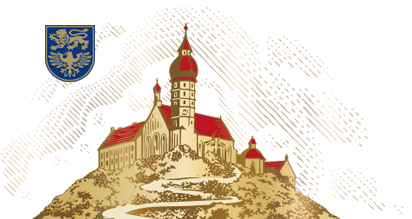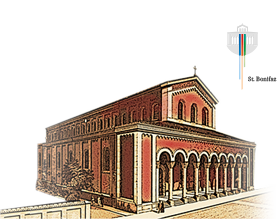- Product range
- History
- Raw materials & brewing process
- Distribution & sales
- Guided Tours
- EMAS environmental certification
- Beer glossary
- Andechs Beer in US
On the way to modernity 1850-1900
From the dissolution of the monastery in 1803 until 1846, the monastery brewery had to engage secular master brewers. However, a successor from within the monastery community soon came forward.
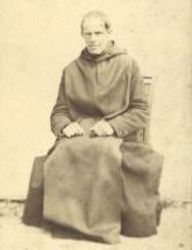
The first master brewer from the monastery ’s ranks after secularisation in 1803 was Brother Ämilian Haltenberger.
He entered Saint Boniface in May of 1854. A skilled brewer, he passed his examination on 28 September 1854 and was “found capable of independently pursuing this trade in communities of all classes”.
Among the monks, he is referred to as “braxator”, brewer, from 1855 onward. When he passed away on 8 January 1865 at the age of 44, Brother Jakob Neubauer became his successor.
Brother Jakob Neubauer
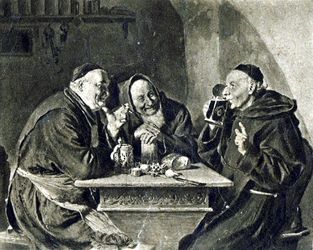
Brother Jakob entered Saint Boniface Abbey in Munich and Andechs in 1858 at the age of 35, took his vows in 1859 and worked in the brewery from then on. He was no skilled brewer but learned on the job.
When he “took office”, a “socius braxatoris”, a brewer’s assistant, also appears from the ranks of the monks for the first time: Kilian Kohl. There will be up to three assistant monks in the coming decades – an important indication of the brewery’s increasing size.
Father Jakob Neubauer passed away on 20 June 1886. He became known mainly through the portraits of his friend, the genre painter Eduard von Grützner (1846-1925).
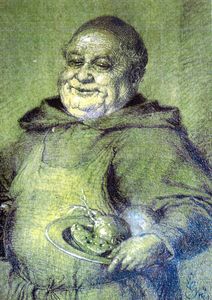
Eduard von Grützner was a regular at the Andechser Bräustüberl and close friends with master brewer Brother Jakob, who became the subject of countless portraits and mood paintings. The Grützner-Stüberl keeps the memory of the beer-loving master, who liked to portray himself as a Benedictine, alive.
Father Willibald Mathäser includes an anecdote in his Andechs chronicle about Brother Jakob, probably the most well-known and popular Andechs master brewer, that describes Brother Jakob’s character in a clear and friendly way:
„Brother Jakobus also addressed Prince Ludwig, who would become Bavaria’s last monarch as King Ludwig III, with the same direct openness. The young member of the Wittelsbach family with his wife Therese came into the Bräustüberl on the Holy Mountain one day when it was busy. There was not an empty chair to be found, indoors or in the garden, which is why Prince Ludwig sent for Brother Jakob with a request to procure some seating. The Brother, who had his hands full serving at the bar, was unable to help. He was short-spoken: “Tell their Majesties to find a spot where they can, like everyone else. A prince and princess are no different than other people.“
Brother Wunibald Siebenhüter
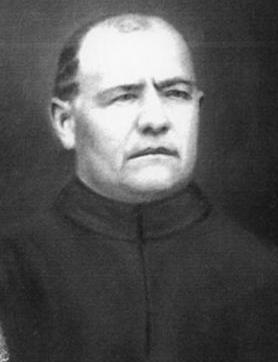
Soon after the passing of Brother Jakob Neubauer on 22 June 1886, he took over management of the monastery brewery on the Holy Mountain in Andechs.
He is noted in the monastery catalogue as “braxator” – master brewer – starting in the year 1887. There he remained until his death on 9 January 1905. Father Willibald Mathäser in his Andechs chronicle (page 249 ff.) reports on the major changes in the monastery brewery during these years.
Among other things, the brewhouse was extensively modernised in 1894. A spacious new storage cellar was driven deep into the Holy Mountain. A new powerhouse with steam power and later also a refrigerating machine from the company Linde were installed under his direction.
The long-time socii braxatoris Brother Ämilian Dempf, Brother Stefan Hebel and Brother Korbinian Schmid – assistants and employees of the master brewer – supported him during those years.
Ongoing investment – Customer relationship management
The brewers were journeymen or masters when they joined, or were trained at the monastery , and got “promoted” from assistant to lead brewer after the death of the respective master brewer. Their “bosses” were the monastery ’s cellerars, who established the conditions for a successful and expanding enterprise through astute management: Father Magnus Sattler (1858-1900), Father Augustin Engl (1900-1924), Father Magnus Rath (1924-1952) and Father Daniel Gerritzen (1968-1986).
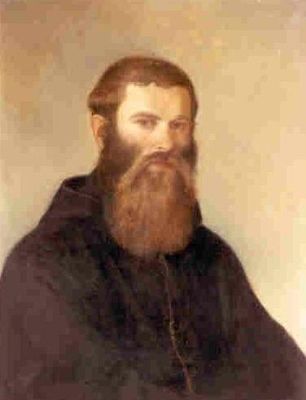
Father Magnus Sattler had the brewery converted to steam power in 1871. The barrel house and warehouse were modernised in 1893, the brewhouse in 1894. Reading his meticulous records for the years of 1858 to 1898 clearly shows what accounted for the success of the Andechs brewery even then, and therefore its increasing economic importance to the monastery: Ongoing investment in the form of structural and machinery improvements along with managing customer relationships and expanding the customer base beyond the Holy Mountain.
This development is documented, in particular, by what are called the barley manuals because, aside from the purchase of barley – telling us that own production was no longer sufficient – they record beer deliveries and the confirmation of payments received from various innkeepers, both in the vicinity and further afield. The Andechs brewery had other customers aside from innkeepers as well. A letter from Father Magnus Sattler to his abbot Benedikt Zenetti dated 14 February 1889 tells us that the matron of the orphanage in Nymphenburg enquired with him whether she could purchase beer from the Andechs Monastery brewery, and if so, what the terms were. Since the orphanage intended to order 10 hectolitres a week, Father Magnus commented: “This clientèle is as large or larger than any of our innkeepers, with the benefit of accurate payment.”
Old brewhouse before 1929
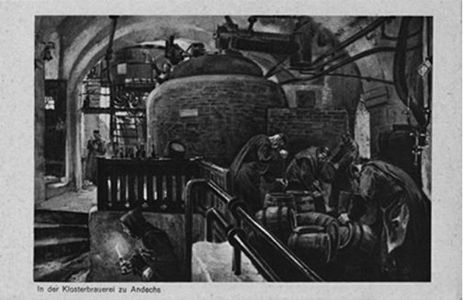
The undated depiction from the archives of the Andechs Monastery shows the monastery brewery’s old brewhouse.
This picture gives us an impression of the situation before the move and the new construction of the brewhouse as well as the conversion to the brewing process in copper kettles in 1929.
It shows the brewhouse constructed under Father Magnus Sattler in 1894, where iron brewing kettles were still being used.


